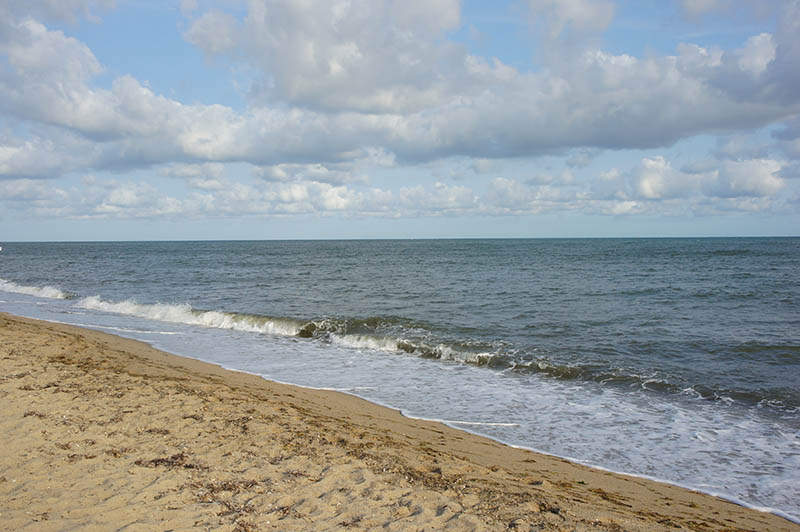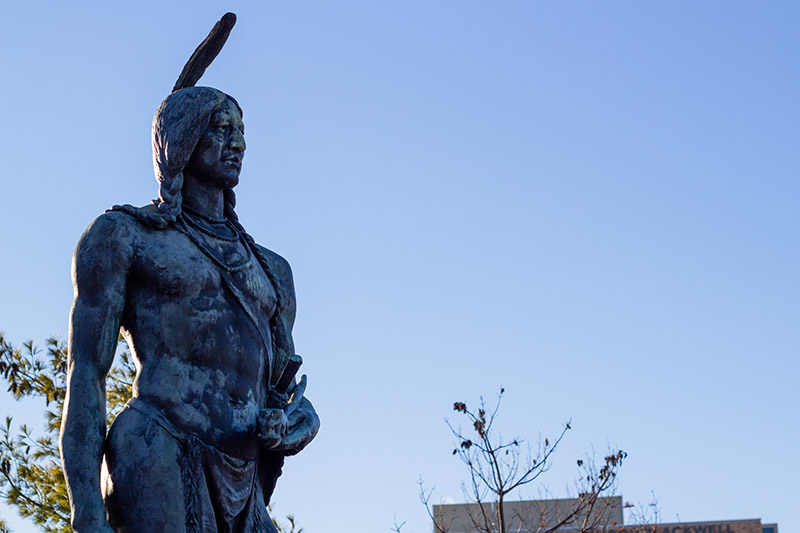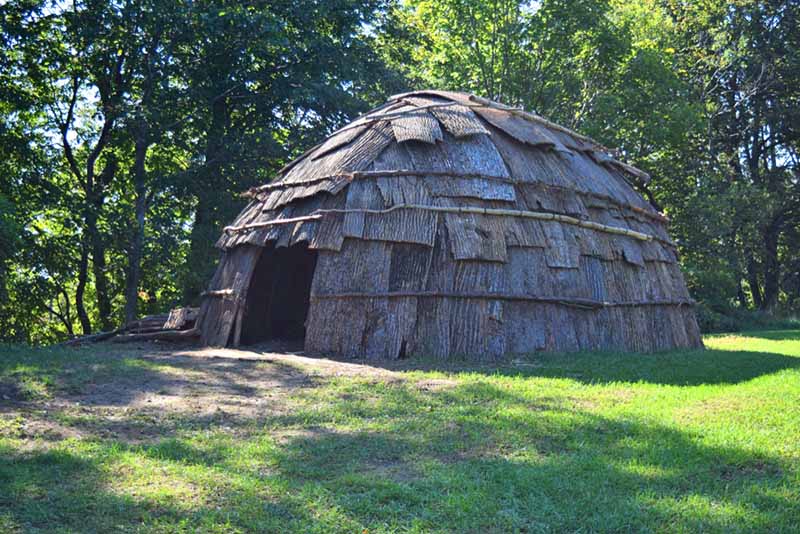

- Contact Us
- Search
-
Mayflower400 partner destinations:
Four hundred years of Wampanoag history
Four hundred years ago, the Wampanoag People watched on as a ship arrived on their shores.
It was not the first ship they had seen arrive, nor would it be the last. But this particular vessel and the people on board would have far and long-lasting consequences for their future and legacy.
The Wampanoag Tribe, also known as the People of the First Light, has inhabited present-day Massachusetts and Eastern Rhode Island for more than 12,000 years.
They were part of a rich tapestry of indigenous people with a vast variety of tribes, societies and cultures numbering many times over those present today.
The history of Native American people is often charted from first contact with Europeans, beginning in 1492 with the arrival of Christopher Columbus, but there are eons of history that stretch back centuries before that period.
You can read about the history of the Wampanoag below, but first take a moment to watch our short film We Are Still Here, made with the help of Native American creative agency SmokeSygnals.
Life before the Mayflower

In the 1600s, there were as many as 40,000 people in the 67 villages that made up the Wampanoag People, who firstly lived as a nomadic hunting and gathering culture.
By about 1000 AD, archaeologists have found the first signs of agriculture, in particular the corn crop, which became an important staple, as did beans and squash.
These villages covered the territory along the east coast. Their people had been living on this part of Turtle Island for more than 12,000 years. The Wampanoag, like many other Native People, often refer to the earth as Turtle Island.
Skilled hunters, gatherers, farmers, and fishers during spring and summer, the Wampanoag moved inland to more protected shelter during the colder months of the year. The Wampanoag had a reciprocal relationship with nature and believed that as long as they gave thanks to the bountiful world, it would give back to them.
The Great Dying
Ships from England had been fishing and trading in North America waters since the beginning of the 16th century. They also took Native Americans back to Europe – some as slaves – often to callously exhibit.
But they also brought an invisible killer to American shores – disease.
Before 1492, the Native American people lived sparsely and were largely isolated from the rest of the world, meaning they were mostly protected from the threat of foreign illness.
This also meant they lacked immunity to the pathogens that would eventually arrive. Europeans were exploring the villages of indigenous people long before the Mayflower arrived, and they spread sickness at a devastating rate.
The most alarming period is known as the ‘Great Dying’ between 1616 and 1619. A mysterious disease ravaged the region where the Wampanoag lived as their lands were explored in greater numbers.
Entire villages were lost and only a fraction of the Wampanoag Nation survived. This meant they were not only threatened by the effects of colonisation but vulnerable to rival tribes and struggled to fend off the neighbouring Narragansett, who had been less affected by this plague.
In the winter of 1616-17 an expedition dispatched by Sir Ferdinando Gorges found a region devastated by war and disease, the remaining people so “sore afflicted with the plague, for that the country was in a manner left void of inhabitants”.
Two years later another Englishman found “ancient plantations” now completely empty with few inhabitants – and those that had survived were suffering.
In the years before the Mayflower arrived, the effects of colonisation had already taken root.
The story of Tisquantum
A Native American called Tisquantum was born in 1580. He became known as Squanto and little is known of his early life.
Some believe he was captured as a young man on the coast of what is now Maine by Captain George Weymouth in 1605. Weymouth was an Englishmen commissioned to explore the American coastline and thought his financial backers might like to see Native American people.
It is said by some that Tisquantum was captured and brought to England along with four others. Whether or not this is the case, he was in his homeland again by 1614, watching another English explorer called Thomas Hunt arrive on his people’s shores.
Hunt lured 24 Native Americans on board his ship under the premise of trade. Their number included Tisquantum. Hunt locked them up below deck, sailed for Spain and sold these people into the European slave trade.
Tisquantum was liberated some years later, when it is thought he returned to America in 1619 working as an interpreter for Captain Thomas Dermer.
He searched for his homeland but tragically, he arrived as the Great Dying reached its horrific climax. His tribe had all been wiped out. His home village, Patuxet, was lost.
It is believed Tisquantum was eventually captured by the Wampanoag, suspicious of his close relationship with Dermer.
The arrival of the Mayflower
The Mayflower’s passengers disembarked at a time of great change for the Wampanoag.
The Wampanoag traditionally worked together – a number of groups united. The heads of these groups were called Sachems, with a head Sachem managing this democratic network where women and men worked in unity, both with a voice on tribal matters.
Attacks from neighbouring tribes meant they had lost land along the coast, and the extraordinary impact of the Great Dying meant the Wampanoag had to reorganise its structure and Sachems had to join together and build new unions.
Four hundred years ago, this newly organised People watched as yet another ship arrived from the east.
These people were different. The Wampanoag watched as women and children walked from the ship, using the waters to wash themselves. Never before had they seen Europeans engage in such an act.
They watched cautiously as the men of this new ship explored their lands, finding what remained of Patuxet and building homes. They watched them take corn and beans, probably winter provisions, stored for the harsh conditions that were to come.
The Wampanoag People did not react.
Given the horrific nature of the past years, the Wampanoag People were understandably wary of this new group. Months would pass before contact. But in this time, they would have recognised the opportunity for a new alliance to help them survive.
Reaching out

A statue of Wampanoag leader Massasoit
During March 1621, an English-speaking Native American named Samoset, was visiting the Wampanoag chief Ousamequin, known as Massasoit. He is said to have entered the grounds of this new colony and introduced himself, and is said to have asked for beer.
Samoset had learned English from the fishermen who had frequented the waters off the American coast and talked to these new settlers, establishing a rapport.
He later returned with deer skins to trade. They didn’t trade on this occasion, but they did exchange food.
A few days later, Samoset returned. With him came Tisquantum, whose experience meant his English was much advanced. The Wampanoag put Tisquantum to the test and freed him to help these new Englishmen.
He taught them to plant corn, which became an important crop, as well as where to fish and hunt beaver.
He introduced them to the Wampanoag chief Ousamequin, an important moment in developing relations.
A temporary peace
At the same time as the arrival of these newcomers, the Wampanoag were still wary of the nearby Narragansett tribe, who had not been affected as badly by the disease epidemics and remained a powerful tribe.
Ousamequin would have sensed an opportunity to align themselves with these new colonists from England, to protect his people from the Narragansett.
In 1621, the Narragansett sent the new colony a threat of arrows wrapped up in snakeskin. William Bradford, who was governor of the colony at the time, filled the snakeskin with powder and bullets and sent it back. The Narragansett knew what this message meant and would not attack the colony.
Ousamequin established with the Mayflower passengers an historic peace treaty. The Wampanoag went on to teach them how to hunt, plant crops and how to get the best of their harvest, saving these people, who would go on to be known as the Pilgrims, from starvation.
This ‘peace’ was not necessarily one the Wampanoag were comfortable with. For a period the two groups’ interests aligned – but in the context of 400 years of history, it is a moment in time.
Thanksgiving
For many years, the Native American people have celebrated days of thanksgiving, long before the English colonists arrived. The English, like many other cultures, also had a tradition of ‘thanksgiving’ celebrations.
In the autumn of 1621, having helped the English survive, a bumper crop prompted a three-day celebration.
We do not know when, if or how the Wampanoag People may have joined this event.
We do know, however, that the celebration happened sometime between September 21 and November 9, 1621. Later, in the 19th century, the event entered American popular imagination as the First Thanksgiving.
One of two first-hand accounts of this celebration was contained in the book Mourt’s Relation, primarily written by Edward Winslow, who held a prominent position in the colony.
Winslow’s account states:
“Our corn did prove well, and God be praised, we had a good increase of Indian corn, and our barley indifferent good, but our peas not worth gathering, for we feared they were too late sown. They came up very well, and blossomed, but the sun parched them in the blossom. Our harvest being gotten in, our governor sent four men on fowling, that so we might after a special manner rejoice together, after we had gathered the fruits of our labors; they four in one day killed as much fowl, as with a little help beside, served the company almost a week, at which time amongst other recreations, we exercised our arms, many of the Indians coming amongst us, and amongst the rest their greatest king Massasoit, with some ninety men, whom for three days we entertained and feasted, and they went out and killed five deer, which they brought to the plantation and bestowed on our Governor, and upon the Captain and others. And although it be not always so plentiful, as it was at this time with us, yet by the goodness of God, we are so far from want, that we often wish you partakers of our plenty.”
Later, the Wampanoag leader Frank James would mark this event in his 1970 speech with these grave words:
“This action by Massasoit was perhaps our biggest mistake. We, the Wampanoag, welcomed you, the white man, with open arms, little knowing that it was the beginning of the end.”
The impact of colonisation

An example of a traditional Wampanoag hut
Politics far from the Wampanoag people’s lands would have a bearing on the future of their way of life.
Another ship came in 1621 and two more in 1623. These people wanted to flee the repressive church rule in England and start a new life on Native American land. They built more settlements and established the beginnings of a new city they called Boston.
They spoke of fleeing persecution, of leaving intolerance behind. In reality, they would create a society just as intolerant towards those who had lived there for thousands of years.
Tisquatum’s role as interpreter and guide embroiled him in the politics of the tribes and new colonies. Like his family, who perished in the Great Dying, he died of a fever brought by the Europeans in 1622, while helping Governor William Bradford of the new colony, now called Plymouth. It is not known where he was buried.
Tensions rose. The colonists brought more disease to which the Native Americans would have no immunity. Smallpox would ravage communities still recovering from the Great Dying. Violence increased.
By the 1630s, the Native Americans of this region, who had lived proudly in tune with nature for centuries, were in the minority in their own lands.
In 1632, missionaries begin to arrive in Wampanoag territory. A man called John Eliot arrived from Cambridge, England, and began to learn the language of the Wampanoag in an effort to translate religious materials into Wopanaotaok (Wampanoag language) for the conversion of Wampanoag to Christianity.
War, though, was not far away. The colonisation of Massachusetts Bay and New England led to the brutal wiping out of the Pequot people by 1637, called the Pequot War. More fighting was to come.
King Philip's War
When Ousamequin died in 1662, his son and heir, Metacom, believed the alliance forged by his father was no longer being honoured by the colonists.
At the same time, the colonies were expanding into Wampanoag land all the time. Relations soured.
The colonists demanded the peace agreement should mean the Wampanoag hand over any guns and hanged three of the tribe for the murder of Christian native John Sassamon in 1675, who had told the Plymouth Colony of a plan to attack English settlements.
Metacom – who was known as King Philip by the English – led an uprising of Wampanoag, Nipmuck, Pocumtuck and Narragansett tribes. They came up against the biggest army the colonial leaders could muster, that fought in coalition with other tribes.
The war is seen as a final attempt to drive out the colonists and lasted 14 months. It is considered the deadliest war in American history.
The colonist army burned villages as they went, killing women and children.
The war decimated the Narragansett, Wampanoag and many smaller tribes, paving the way for additional English settlements.
Thousands were killed, wounded or captured and sold into slavery or indentured servitude. Decades after the Wampanoag helped the English survive in their lands, they were now enslaved by those very people.
Metacom fled to Mount Hope where he was finally killed. He was hanged, beheaded, drawn and quartered. His head was placed on a spike and displayed at Plymouth Colony for two decades.
Metacom’s lost belt
The man who killed Metacom was called Captain Benjamin Church. Tribal treasures were turned over to Church, including his legendary Wampum Belt.
Wampum Belts are revered by the Wampanoag People. They were highly important items – woven beads made from shells. Metacom’s belt served as a document of the tribe’s history interpreted through images and symbols woven into the design.
The diary of Church’s son states:
“Philip’s belt, curiously woven of wampum nine inches broad in black and white figures and flowers, and many pictures of birds and bears. This when hung upon Captain Church’s shoulders it reached to his ankles. And another belt of wampum he presented to him wrought after the former manner, which Philip was wont to put upon his head. It had two flags on the back part which hung down his back, and another small belt with a star upon the end of it, while he used to hang upon his breast.”
The loss of Metacom’s belt has reverberated through the centuries and the search for it goes on today.
You can watch a short film about its history, and the creation of a new belt by Wampanoag artists below.
The American Revolution
In 1770, Crispus Attucks, thought to be a Wampanoag, was killed in the Boston Massacre. He was regarded to be the first death, and thus the first to die in the American Revolution.
The Mashpee Wampanoag tribe members went on to fight on behalf of independence in the American Revolution but for more than 200 years they would battle for the rights to their land, right up to the present day where their fight lives on in the courts.
Later, the mythology of the story of the Pilgrim Fathers would develop. The Wampanoag’s version of events, including their eventual near total destruction, would become boiled down into the friendly story of Thanksgiving.
The National Day of Mourning
In 1970, the Wampanoag leader, Frank James, was asked to speak on the anniversary of Thanksgiving, in the year of the 350th anniversary of the Mayflower’s sailing.
But he was told his speech was inappropriate and inflammatory. He was given a revised speech, which he refused to read.
Supporters followed James to hear him give his original speech on Cole’s Hill, next to the statue of Ousamequin. This became the first National Day of Mourning, which continues today in Plymouth, Massachusetts, on the same day as Thanksgiving.
Here is his suppressed speech:
I speak to you as a man -- a Wampanoag Man. I am a proud man, proud of my ancestry, my accomplishments won by a strict parental direction ("You must succeed - your face is a different color in this small Cape Cod community!"). I am a product of poverty and discrimination from these two social and economic diseases.
I, and my brothers and sisters, have painfully overcome, and to some extent we have earned the respect of our community. We are Indians first - but we are termed "good citizens." Sometimes we are arrogant but only because society has pressured us to be so.
It is with mixed emotion that I stand here to share my thoughts. This is a time of celebration for you - celebrating an anniversary of a beginning for the white man in America. A time of looking back, of reflection.
It is with a heavy heart that I look back upon what happened to my People. Even before the Pilgrims landed it was common practice for explorers to capture Indians, take them to Europe and sell them as slaves for 220 shillings apiece. The Pilgrims had hardly explored the shores of Cape Cod for four days before they had robbed the graves of my ancestors and stolen their corn and beans.
Mourt's Relation describes a searching party of sixteen men. Mourt goes on to say that this party took as much of the Indians' winter provisions as they were able to carry. Massasoit, the great Sachem of the Wampanoag, knew these facts, yet he and his People welcomed and befriended the settlers of the Plymouth Plantation. Perhaps he did this because his Tribe had been depleted by an epidemic. Or his knowledge of the harsh oncoming winter was the reason for his peaceful acceptance of these acts. This action by Massasoit was perhaps our biggest mistake. We, the Wampanoag, welcomed you, the white man, with open arms, little knowing that it was the beginning of the end; that before 50 years were to pass, the Wampanoag would no longer be a free people.
What happened in those short 50 years? What has happened in the last 300 years?
Today, and Mayflower 400

Paula Peters holding a Wampum Belt
About 4,000-5,000 Wampanoag live in New England today, and only six visible tribal communities remain from the original 69 in the Wampanoag Nation.
Recently, relations in the Caribbean islands have been found. These people are descendants of Native Wampanoag People who were sent into slavery after King Phillip’s war.
The Wampanoag still continue their way of life through oral traditions, ceremonies, the Wampanoag language, song and dance, social gatherings, hunting and fishing.
Their community is vibrant, and their culture honours their ancestors. In 2020, their very existence is marked by the words “we are still here”. The significance of this phrase comes from the sometimes-casual assumption by the wider world that the Wampanoag no longer exist, that they were wiped out. The opposite is true – the descendants of the proud People who watched European ships arrive on their shores from the east are still here today, living on the land their ancestors celebrated.
They are central to the Mayflower 400 anniversary, a true four-nation commemoration between the Wampanoag Nation, the USA, the UK and the Netherlands.
The words “we are still here” echo through this anniversary, as does centuries of Wampanoag history and the voices of those determined to keep the stories of their ancestors alive through a series of commemorative projects, exhibitions and events.
The creation of a new Wampum Belt is a cornerstone of this anniversary. This hugely symbolic belt will tour England for the anniversary and help tell the Wampanoag story on English land, alongside other projects such as This Land – a community-led international theatre production featuring English citizens and members of the Wampanoag tribe.
Mayflower 400 commemorates the shared history of our nations, a unique anniversary that represents an historic understanding.
Sign up for the latest Mayflower 400 news
You'll be the first to hear the latest Mayflower news, events, and more.
Log In
Register
Mayflower 400 Proudly Supported by our National Sponsors and Funding Partners






